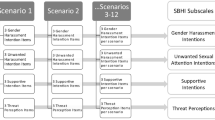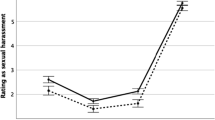Abstract
This study was designed to investigate sexual harassment perceptions based on continuation of unwanted sexual attention following victim resistance. Participants were 504 undergraduates who responded to statements regarding a sexual harassment scenario, in which the perpetrator continued or discontinued attention, which varied in severity according to nonphysical, physical, or restraint contact. Results showed that continued attention and any type of physical contact strengthened harassment perceptions, although men’s perceptions were weaker unless restraint was present. No sex differences were observed in the restraint condition. Women had stronger perceptions than men did in the physical condition, but showed a non-significant trend toward stronger perceptions in the nonphysical condition. Findings suggest that continuation following resistance may clarify for observers that harassment is occurring. Conceptualizations of harassment severity are suggested.
Similar content being viewed by others
References
Baker, D. D., Terpstra, D. E., & Larntz, K. (1990). The influence of individual characteristics and severity of harassing behavior on reactions to sexual harassment. Sex Roles, 22, 305–325.
Baron, R. S., Vandello, J. A., & Brunsman, B. (1996). The forgotten variable in conformity research: Impact of task importance on social influence. Journal of Personality and Social Psychology, 71, 915–927.
Blakely, G. L., Blakely, E. H., & Moorman, R. H. (1995). The relationship between gender, personal experience, and perceptions of sexual harassment in the workplace. Employee Responsibilities and Rights Journal, 8, 263–274.
Burgess, D., & Borgida, E. (1997). Sexual harassment: An experimental test of the sex-role spillover theory. Personality and Social Psychology Bulletin, 23, 63–75.
Burian, B. K., Yanico, B. J., & Martinez, C. R. (1998). Group gender composition effects on judgments of sexual harassment. Psychology of Women Quarterly, 22, 465–480.
Cassidy, L., & Hurrell, R. M. (1995). The influence of victim’s attire on adolescents’ judgment of date rape. Adolescence, 30, 319–323.
Cochran, C. C., Frazier, P. A., & Olson, A. M. (1997). Predictors of responses to unwanted sexual attention. Psychology of Women Quarterly, 21, 207–226.
Cohen, A. F., & Gutek, B. A. (1985). Dimensions of perceptions of social-sexual behavior in a work setting. Sex Roles, 13, 317–327.
Corr, P. J., & Jackson, C. J. (2001). Dimensions of perceived sexual harassment: Effects of gender and status/liking of protagonist. Personality and Individual Differences, 30, 525–539.
De Judicibus, M., & McCabe, M. P. (2001). Blaming the target of sexual harassment: Impact of gender role, sexist attitudes, and work role. Sex Roles, 44, 401–417.
Dougherty, T. W., Turban, D. B., Olson, D. E., Dwyer, P. D., & Lapreze, M. W. (1996). Factors affecting perceptions of workplace sexual harassment. Journal of Organizational Behavior, 17, 489–501.
Ellis, S., Barak, A., & Pinto, A. (1991). Moderating effects of personal cognitions on experienced and perceived sexual harassment of women at the workplace. Journal of Applied Social Psychology, 21, 1320–1337.
Fitzgerald, L. F., Drasgow, F., Hulin, C. L., Gelfand, M. J., & Magley, V. J. (1997). Antecedents and consequences of sexual harassment in organizations: A test of an integrated model. Journal of Applied Psychology, 82, 578–589.
Frazier, P. A., Cochran, C. C., & Olson, A. M. (1995). Social science research on lay definitions of sexual harassment. Journal of Social Issues, 51, 21–37.
Foulis, D., & McCabe, M. P. (1997). Sexual harassment: Factors affecting attitudes and perceptions. Sex Roles, 37, 773–798.
Gervasio, A. H., & Ruckdeschel, K. (1992). College students’ judgments of verbal sexual harassment. Journal of Applied Social Psychology, 22, 190–211.
Gutek, B. A. (1995). How subjective is sexual harassment? An examination of rater effects. Basic and Applied Social Psychology, 17, 447–467.
Gutek, B. A., Cohen, A. G., & Konrad, A. M. (1990). Predicting social-sexual behavior at work: A contact hypothesis. Academy of Management Journal, 33, 560–577.
Gutek, B. A., & Koss, M. P. (1993). Changed women and changed organizations: Consequences of and coping with sexual harassment. Journal of Vocational Behavior, 42, 28–48.
Henry, J., & Meltzoff, J. (1998). Perceptions of sexual harassment as a function of target’s response type and observer’s sex. Sex Roles, 39, 253–271.
Hesson-McInnis, M. S., & Fitzgerald, L. F. (1997). Sexual harassment: A preliminary test of an integrative model. Journal of Applied Social Psychology, 27, 877–901.
Hurt, J. L., Maver, J. A., & Hofmann, D. (1999). Situational and individual influences on judgments of hostile environment sexual harassment. Journal of Applied Social Psychology, 29, 1395–1415.
Icenogle, M. L., Eagle, B. W., Ahmad, S., & Hanks, L. A. (2002). Assessing perceptions of sexual harassment behaviors in a manufacturing environment. Journal of Business and Psychology, 16, 601–616.
Johnson, J. D., Benson, C., Teasdale, A., Simmons, S., & Reed, W. (1997). Perceptual ambiguity, gender, target intoxication: Assessing the effects of factors that moderate perceptions of sexual harassment. Journal of Applied Social Psychology, 27, 1209–1221.
Jones, T. S., & Remland, M. S. (1992). Sources of variability in perceptions of and responses to sexual harassment. Sex Roles, 27, 121–142.
Jones, T. S., Remland, M. S., & Brunner, C. C. (1987). Effects of employment relationship, response of recipient, and sex of rater on perceptions of sexual harassment. Perceptual and Motor Skills, 65, 55–63.
Kirk, R. E. (1995). Experimental design procedures for the behavioral sciences. Pacific Grove, CA: Brooks/Cole.
Kopper, B. A. (1996). Gender, gender identity, rape myth acceptance, and time of initial resistance on the perception of acquaintance rape blame and avoidability. Sex Roles, 34, 81–91.
Loredo, C., Reid, A., & Deaux, K. (1995). Judgments and definitions of sexual harassment by high school students. Sex Roles, 32, 29–45.
Magley, V. J., Hulin, C. L., Fitzgerald, L. F., & DeNardo, M. (1999). Outcomes of self-labeling sexual harassment. Journal of Applied Psychology, 84, 390–402.
Matsui, T., Kakuyama, T., Onglatco, M., & Ogutu, M. (1995). Women’s perceptions of social sexual behavior: A cross-cultural replication. Journal of Vocational Behavior, 46, 203–215.
McKinney, K. (1992). Contrapower sexual harassment: The effects of student sex and type of behavior on faculty perceptions. Sex Roles, 27, 627–643.
Muehlenhard, C. L., & Hollabaugh, L. C. (1988). Do women sometimes say no when they mean yes? The prevalence and correlates of women’s token resistance to sex. Journal of Personality and Social Psychology, 54, 872–879.
O’Donohue, W., Downs, K., & Yeater, E. A. (1998). Sexual harassment: A review of the literature. Aggression and Violent Behaviour, 3, 111–128.
Osman, S. L. (2004). Victim resistance: Theory and data on understanding perceptions of sexual harassment. Sex Roles, 50, 267–275.
Pryor, J. B. (1995). The phenomenology of sexual harassment: Why does sexual behavior bother people in the workplace? Consulting Psychology Journal, 47, 160–168.
Remland, M. S., & Jones, T. S. (1985). Sex differences, communication consistency, and judgments of sexual harassment in a performance appraisal interview. Southern Speech Communication Journal, 50, 156–176.
Rhodes, A. K., & Stern, S. E. (1994). Ranking harassment: A multidimensional scaling of sexual harassment scenarios. Journal of Psychology, 129, 29–39.
Satterfield, A. T., & Muehlenhard, C. L. (1997). Shaken confidence: The effects of an authority figure’s flirtatiousness on women’s and men’s self-rated creativity. Psychology of Women Quarterly, 21, 395–416.
Schneider, K. T., Swan, S., & Fitzgerald, L. F. (1997). Job-related and psychological effects of sexual harassment in the workplace: Empirical evidence from two organizations. Journal of Applied Psychology, 82, 401–415.
Sheets, V. L., & Braver, S. L. (1999). Organizational status and perceived sexual harassment: Detecting the mediators of a null effect. Personality and Social Psychology Bulletin, 25, 1159–1171.
Shotland, R. L., & Goodstein, L. (1983). Just because she doesn’t want to doesn’t mean it’s rape: An experimentally based causal model of the perception of rape in a dating situation. Social Psychology Quarterly, 46, 220–232.
Soloman, D. H., & Williams, M. L. M. (1997). Perceptions of social-sexual communication at work: The effects of message, situation, and observer characteristics on judgments of sexual harassment. Journal of Applied Communications Research, 25, 196–216.
Stockdale, M. S. (1998). The direct and moderating influences of sexual-harassment pervasiveness, coping strategies, and gender on work-related outcomes. Psychology of Women Quarterly, 22, 521–535.
Summers, R. J. (1991). Determinants of judgments of and responses to a complaint of sexual harassment. Sex Roles, 25, 379–392.
Summers, R. J., & Myklebust, K. (1992). The influence of a history of romance on judgments and responses to a complaint of sexual harassment. Sex Roles, 27, 345–357.
Tata, J. (1993). The structure and phenomenon of sexual harassment: Impact of category of sexually harassing behavior, gender, and hierarchical level. Journal of Applied Social Psychology, 23, 199–211.
Tata, J. (2000). She said, he said: The influences of remedial accounts on third-party judgments of coworker sexual harassment. Journal of Management, 26, 1133–1156.
Terpstra, D. E., & Baker, D. D. (1987). A hierarchy of sexual harassment. Journal of Psychology, 12, 599–605.
Thomann, D. A., & Wiener, R. L. (1987). Physical and psychological causality as determinants of culpability in sexual harassment cases. Sex Roles, 17, 573–591.
US Equal Employment Opportunity Commission (1992). Questions and answers about sexual harassment. Cincinnati, OH: EEOC Publications Center.
US Equal Employment Opportunity Commission (1994). Facts about sexual harassment. Cincinnati, OH: EEOC Publications Center.
US Merit Systems Protection Board (1981). Sexual harassment of federal workers: Is it a problem? Washington, DC: US Government Printing Office.
US Merit Systems Protection Board (1988). Sexual harassment in the federal government: An update. Washington, DC: US Government Printing Office.
US Merit Systems Protection Board (1995). Sexual harassment in the federal workplace: Trends, progress, continuing challenges. Washington, DC: US Government Printing Office.
Williams, C. W., Brown, R. S., Lees-Haley, P. R., & Price, J. R. (1995). An attributional (causal dimensional) analysis of perceptions of sexual harassment. Journal of Applied Social Psychology, 25, 1169–1183.
Williams, C. L., Giuffre, P. A., & Dellinger, K. (1999). Sexuality in the workplace: Organizational control, sexual harassment, and the pursuit of pleasure. Annual Review of Sociology, 25, 73–93.
York, K. M. (1989). Defining sexual harassment in workplaces: A policy-capturing approach. Academy of Management Journal, 32, 830–850.
Author information
Authors and Affiliations
Corresponding author
Rights and permissions
About this article
Cite this article
Osman, S.L. The Continuation of Perpetrator Behaviors that Influence Perceptions of Sexual Harassment. Sex Roles 56, 63–69 (2007). https://doi.org/10.1007/s11199-006-9149-1
Published:
Issue Date:
DOI: https://doi.org/10.1007/s11199-006-9149-1




